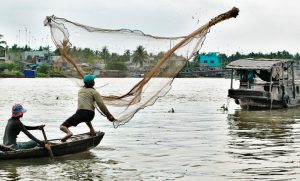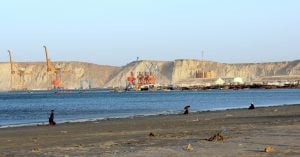Spearheaded by Brazil and Argentina, the relationship between Latin America and China is viewed increasingly positively, but is also subject to new political contexts and demands. Argentine president Mauricio Macri’s trip to China on May 15 will serve to strengthen bilateral relations but also create a pathway for dialogue in which Mercosur – a political and economic bloc comprising Brazil, Argentina, Uruguay, Paraguay and, though it’s at risk of expulsion, Venezuela – can speak with one voice in future negotiations with China. Within Mercosur, China operates as an influential factor in decision-making on industrial, commercial, investment and sub-regional infrastructure projects.
In its relations with China, both Mercosur and the Pacific Alliance – the trade bloc made up of Mexico, Colombia, Peru and Chile – play an important role in negotiations, compliance and the harmonisation of environmental standards, in the trade arena, and specifically in chapters on non-tariff barriers (NTBs). Our economies are subject to international standards and are signatories to multilateral treaties on the subject. Their applicability is of the utmost importance since imports from Asia’s developing countries sometimes fail to meet minimum standards. Likewise, regional exports that meet international standards are sometimes subject to protectionism, and denied access to markets such as China. Also, in their chapters on foreign direct investment (FDI) and financing by Chinese entities, future projections must factor-in compliance with conditions on ecological sustainability that respect environments, both urban and rural, in our countries.
China and Latin America: An evolving relationship
Since the beginning of the 21st century, relations between China, Latin America and the Caribbean (LAC) have undergone a period of intensification and increasing interdependence. However, at present, due to persistent trade imbalances and asymmetries, they are being re-evaluated, both by the region, and by China. In almost twenty years, China has moved from having a marginal role in the social imaginary to one that Latin American economies consider a vital market for regional exports, which can foster a higher rate of regional economic growth. This has had varying impacts on the general wellbeing of some particularly vulnerable sectors.
According to the Economic Commission for Latin America and the Caribbean (ECLAC), for the period 2000-2015, trade multiplied some 22 times, showing that China had become the region’s second trading partner after the US, and the main trading partner for Brazil, Chile, Peru and Venezuela. While the relationship is complimentary (Latin America exports the products China needs to fuel its growth) it is at the same time asymmetrical: Latin America’s comparative advantage (its ability to produce goods at a lower cost than other countries) lies with the provision of raw materials, and this is exchanged for the importation of consumer and industrial goods coming from China.
The benefits of LAC’s export dynamism, mainly from extractive industries, were offset by the importation of competitive Chinese goods and services. This had the consequences of “primarisation” (a return to primary industries, or de-industrialisation) and the concentration of regional exports in a few products. Both factors progressively diminished the benefits derived from a relationship, which at the beginning had been considered highly valuable and vital to regional development. In this respect, in the period since 2000 LAC also became an important recipient of Chinese foreign direct investment (FDI). But the latter is characterised by a concentration in the extractive sectors, and prioritises resource-seeking approaches, with few productive links, the generation of minimal value locally and low or no technological transfer. Through the purchase of land, business acquisitions, and the growth of mining projects, Chinese FDI progressed in the region in Argentina, Venezuela, Brazil, Colombia, Peru, Bolivia and Ecuador, particularly in sectors such as food processing, energy and mining.
On many occasions governments signed agreements without taking into account local interests, and the vulnerability of indigenous or local communities. Nor did Chinese firms feel the need to consider environmental impacts and the disruption caused through their projects uprooting, displacing communities or destroying ecosystems. This led to increased criticism of Chinese capital investment, which aims to intensify the exploitation of resources. However, rural and indigenous protests in Argentina, Peru, Bolivia, Ecuador, and even Nicaragua, were seen as disruptive to investment projects that would a priori generate profits, but that might not objectively contribute to the development of a national production matrix or generate employment.
As a consequence, and by taking on board criticism from LAC, China is seeking to readjust its regional strategy in order to take advantage of opportunities opened by these dynamic domestic and regional markets. Acknowledging the criticisms, the Chinese government prioritised the need to introduce changes aimed at diversifying FDI destinations (both state and/or private) towards new industrial sectors, and alliances with local firms to meet local, regional or third market demands, as well as to increase the transfer of technology to the region. Sectors of particular interest are aerospace, unconventional energies, information and communication technologies (ICTs), biotechnology, new materials and pharmacology. Also, China proposes greater access to its market for a wide array of exported Latin American goods, the formation of technological alliances, and a push from the government, for its companies to allow the inclusion of Latin American companies in the Global Value Chains (GVCs).
A third axis of mutual interdependence has been the financial one, also under review. According to data provided by the China-Latin America Finance Database, Chinese loans to the region amounted to US$142 billion between 2005 and 2014 with the main lender being China Development Bank (CDB). The main beneficiaries include Venezuela, Brazil, Argentina and Ecuador. However, Chinese funding is tied to “conditionalities” such as the provision of raw materials (oil, minerals) or the granting of preferential conditions to Chinese firms in tenders for infrastructure projects or government procurement.
In this new phase, this form of finance, which has also come in for criticism, seeks to “institutionalise” agreements and reject ad hoc agreements, in order to exert greater local control over financial flows and introduce environmental impact parameters, the expansion of local assembly operations and a greater participation of national producers in joint projects.
Looking to the future
At the multilateral level, China aims to take advantage of opportunities presented by sub-regional blocs such as Mercosur and the Pacific Alliance, as well as those from an incipient process of integrating almost the entire South American geo-economic space, through the Community of Latin American and Caribbean States (CELAC). China prioritises dialogue with CELAC as it looks towards cooperation and harmonisation of trade procedures. The China-CELAC Cooperation Programme 2015-2019 includes a credit package consisting of the “China-LAC Investment Fund” for Industrial Cooperation worth US$10 billion, a Special Projects Loan Programme for infrastructure projects worth US$20 billion, and an additional US$5 billion for the already established China-LAC Cooperation Fund. Notwithstanding this readjustment of the Chinese strategy towards the region, these agreements will remain in force.
Regarding the Pacific Alliance (AP in the Spanish acronym), China already interacts with member economies in various fora such as the Asia-Pacific Cooperation Forum (APEC) and has signed Free Trade Agreements (FTAs) with Chile and Peru. China increased its economic ties with Colombia and is discussing with Mexico a new framework of bilateral relations, taking into account internal NAFTA (North American Free Trade Agreement) tensions and interest in its powerful domestic market.
In a context marked by a number of simultaneous action plans, Chinese strategists are interested in working out a possible “road map” for Mercosur and convergence with AP that includes the harmonisation of regulatory frameworks, technical, sanitary and phytosanitary standards, trade facilitation and customs procedures, customs information, goods valuation criteria, dispute settlement and government procurement. If a general framework for joint negotiation with China comes to pass, the agenda could include regional commitments on long-term supply, the provision of higher value-added products, technological alliances, the expansion of an associated menu of services, deregulation of the financial sector favourable to Chinese institutions, participation of Latin American banks in the One Belt One Road (OBOR) initiative for China-Eurasian interconnectivity, and expanding the menu of logistics services. On the other hand, it will be interesting to see if new intra-regional public works, transportation, energy, and communications projects are totally or partially financed by China. South American countries’ membership of the Asian Bank of Investment in Infrastructure (AIIB), the bank set up to finance OBOR, is also worth watching. Brazil is already a member, and Argentina could consider joining.
Rather than being considered just a privileged trading partner, LAC actually aims to build a “partnership for shared development” with China. Adjustments are necessary on both sides in order to meet higher levels of transparency, reduce trade asymmetries and make investments comply with environmental preservation. The changes in the Latin American political scenario, and the resulting regulatory environments are key to understanding this long-term, ongoing processes.








